
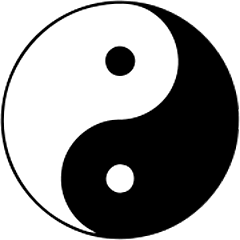
|
|
|
|
Kamikaze Bard, dressing
down in stylish black kimono (a sort of Japanese dressing gown)
rather than his habitual stage samurai outfit, slowly sips at
a bowl of ceremonial-grade, jade green matcha,
Kakuzo Okakura's
The Book of Tea
beside him.
When not in full flight poetically (& as KAMIKAZE
Bard, he is prone to crash), he passes the odd, off-duty moment sitting still in
quiet reflection, ephemeral appearances arising in his mind's shining
mirror. On a typical day that is...
|
|
***
Well, can't say I'm really into Martial Arts. Am no Karate Kid or Judo Juvenile. I did go to some Aikido classes in the 1980s, as an adult in my 30s (just numbers.) Gave up in utter humiliation after being thrown by an 8 year old girl, much smaller & lighter than me. I know, I know, ego shouldn't come into it. Anyway, learnt how to roll across the floor from a standing start & know how to break someone's arm, if they are foolish enough to grab me by the wrist. These are useful skills, admittedly not often called for.
There have been periods in my life when I was socially adrift, a metaphorical “wave man” or Ronin, but definitely didn’t become a Kensei like Miyamoto Musashi.
No Katana in my cutlery drawer. Am in no hurry for Harakiri. Seppuku lacks seductive appeal. Am no Mishima. Confess to being bloody squeamish. Can see no glory in gore. I do have a nice little Japanese chopping knife... for vegetables that is, you won't find meat or fish in this house.
However, I eat many traditional Japanese foods. How that came about is stranger than fiction: in 1972, at the tender age of 21 (yet more numbers), while, paradoxically, studying English at a Scottish University, I met a French Macrobiotic hairdresser, who had cooked Miso Soup & Hokkaido Pumpkin Pie for John Lennon in Toronto. Under his tutelage (& books like Zen Macrobiotics by George Ohsawa), I adopted the diet myself for a number of years, though I no longer adhere to it strictly in terms of putative yin/yang ratio, preferring a broader organic, plant-based wholefood approach to nutrition (vegan, foregoing any fish).
Anyway, I was soon making & eating Nori-wrapped rice balls with an umeboshi plum in the middle, an excellent picnic snack, which will last unrefrigerated for days, as the salted plum preserves the rice. With other seaweeds (or sea vegetables might sound more appetising to the uninitiated) like Kombu, Wakame, Hizike, Arame, the kitchen became redolent of the seaside.
Miso, Tamari, Shoyu, Mirin, Tofu, Tempeh, Tahini, Wasabi, Kuzu, Azuki beans.... names & tastes very exotic for a working-class English lad, brought up in a Council House during the1950s, weaned on meat & two veg till, in a heartfelt gesture of compassionate rebellion, I became vegetarian at age 16 in 1967.
Goes without saying, for scrubbing vegetables, I used a Tawashi. I'd grind sesame seeds in a Suribachi & make Gomasio. My vocabulary was turning Japanese...
Mmm Umami! Although that's a neologism in Japanese, the English language doesn't have a word that conveys the same, so we use the loanword. Yummy in any language. I find the grub I eat oishii (delicious.) Can't say the same about the grubs I find.
I love good food & spend a lot of the household budget on it. There's a Japanese word for that: Kuidaore (means something like "ruin oneself by extravagance in food".)
***
Japanese Ceramics, not China! I eat all my meals in these beautiful bowls:

They bowl me over! Tempting fate to say they are smashing! (Sorry about that. Not wishing to punish you with those irresistibly obvious puns!) Attractive crockery does seem to enhance the flavour of the food. Part of a feast for the eyes as well as the taste buds,
The kanji on
the cup below says Shiawase, which means Happiness. That will do me. Am
happy to sip tea from it. Cheers!

|
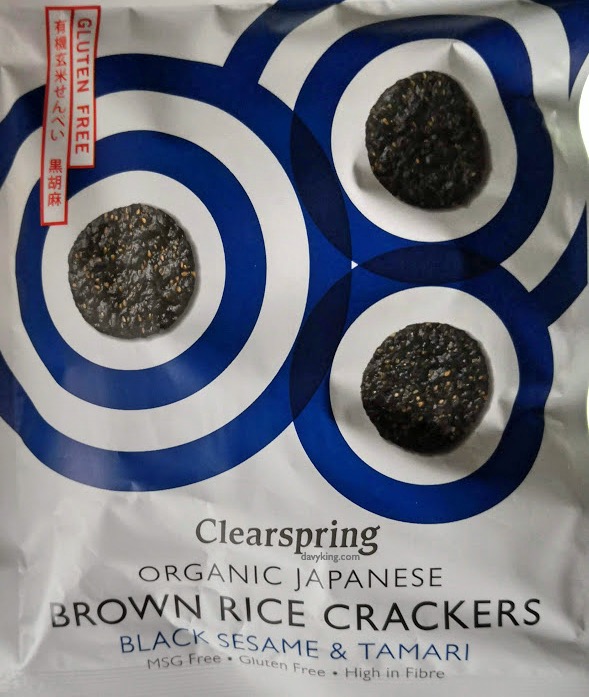 |
Such good eating has kept me quite trim, so I’d have to put on a lot of weight for Sumo.
Had better stick to Sumi-e, instead. Well, I have a bamboo-handled, bristled calligraphy brush, now a bit tousled, like my hair too. Black ink, washi paper with kozo fibre. Attempt umpteenth Enso. Not quite perfect circle. Looks like snake head swallowing tail, a nipponese Ouroboros. Have a printed one hanging on the wall, but maybe that's cheating. Photo of it below, with some personal annotations. One could try painting round a rice cake, though, strictly-speaking, tradition wouldn't countenance the practice & there's a risk of of ink-ingestion if said rice cake were subsequently eaten.

"Ensō (円相) is a Japanese word meaning "circle". It symbolizes the Absolute, enlightenment, strength, elegance, the Universe, and the void; it also may be taken to symbolize the Japanese aesthetic itself." - Wikipedia
***
Did this Kamikaze Bard logo featuring Hokusai's Great Wave, in the early 1980s. Used Japanese calligraphy brush, referred to above, for "authenticity."
Rather fond of Hiroshige too, so much so have just been inspired to compose this:
53 Stations of the Tōkaidō (an Ode)
| from Edo to Kyoto on that old Tōkaidō road ever since he strode along it station to station Utagawa Hiroshige caused a great sensation with those telling woodcut prints by dint of his economy of style where subtle hints & tints convince such a well-observed creation got much appreciation bestowed success on Andō |
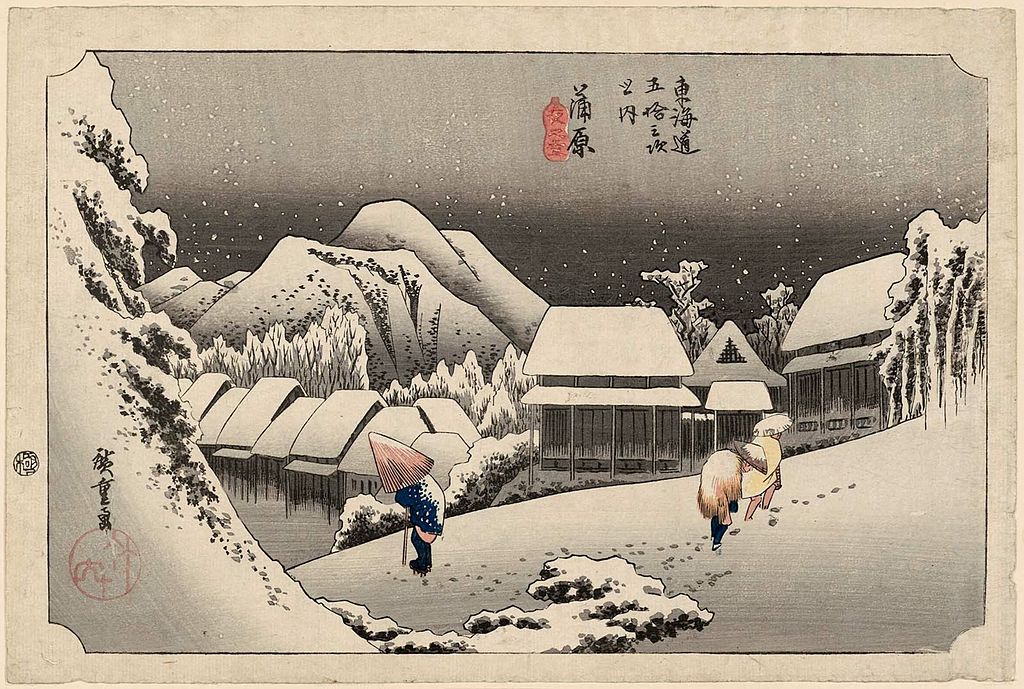 |
(The other 53 prints are definitely worth looking at too)
Also adore his woodblock prints of Plum Blossom.
There's a plum tree in the garden. Next Spring, if I live that long, must take some more photos of it, much quicker & easier than carving wood.
Meanwhile, here's some 2020 vintage Cherry Blossom, which I cultivated (i.e. it just grew naturally on a tree I planted many years ago.):
Spring Cherry Blossom
awaiting a haiku
eloquent without one
"In Japan, cherry blossoms symbolize clouds due to their nature of blooming en masse, besides being an enduring metaphor for the ephemeral nature of life, an aspect of Japanese cultural tradition that is often associated with Buddhist influence, and which is embodied in the concept of mono no aware. The transience of the blossoms, the exquisite beauty and volatility, has often been associated with mortality and graceful and readily acceptance of destiny and karma; for this reason, cherry blossoms are richly symbolic, and have been utilized often in Japanese art, manga, anime, and film, as well as at musical performances for ambient effect. There is at least one popular folk song, originally meant for the shakuhachi (bamboo flute), titled “Sakura” , and several pop songs. The flower is also represented on all manner of consumer goods in Japan, including kimono, stationery, and dishware....
Mono no aware (物の哀れ), literally "the pathos of things", and also translated as "an empathy toward things", or "a sensitivity to ephemera", is a Japanese term for the awareness of impermanence (無常, mujō), or transience of things, and both a transient gentle sadness (or wistfulness) at their passing as well as a longer, deeper gentle sadness about this state being the reality of life. "Mono-no aware: the ephemeral nature of beauty – the quietly elated, bittersweet feeling of having been witness to the dazzling circus of life – knowing that none of it can last. It’s basically about being both saddened by and appreciative of transience – and also about the relationship between life and death. In Japan, there are four very distinct seasons, and you really become aware of life and mortality and transience. You become aware of how significant those moments are.” - Wikipedia
My young son said "if you take a blossom from a cherry tree and carry it home, it withers" (he had done so the day before), "it's like the life-cycle, when you get old you get wrinkles." An astute observation from a then 6 year old I thought. His reference to wrinkles was a brutally honest description of his ageing father (ie Yours TrulyTM).
The sight of Cherry Blossom cheers me up each spring. I appreciate the beauty of the blossom, the more so because it's so ephemeral. Look forward to eating juicy cherries in their season as well. Life is just a bowl of them? (Genoa cake, anyone?)
|
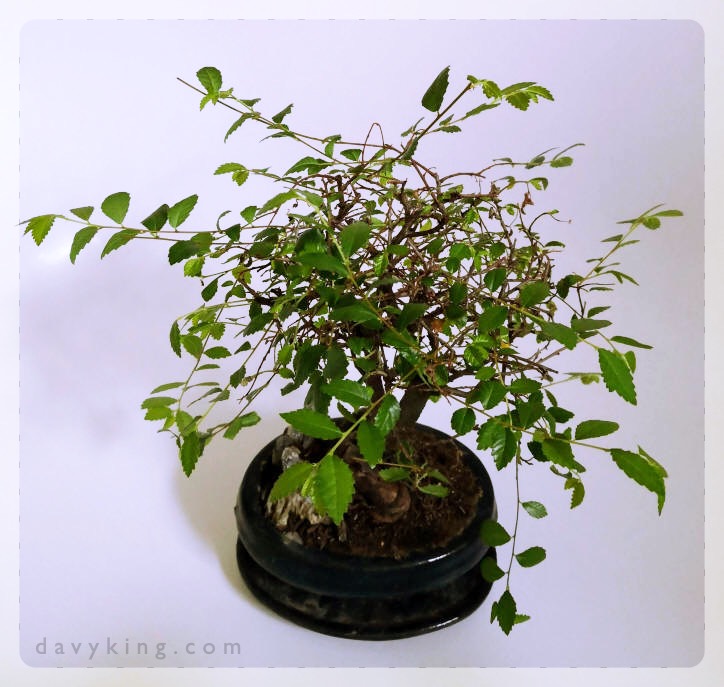 |
"In traditional Japanese aesthetics, wabi-sabi (侘寂) is a world view centered on the acceptance of transience and imperfection.The aesthetic is sometimes described as one of beauty that is "imperfect, impermanent, and incomplete". It is a concept derived from the Buddhist teaching of the three marks of existence (三法印, sanbōin), specifically impermanence (無常, mujō), suffering (苦, ku) and emptiness or absence of self-nature (空, kū).Characteristics of the wabi-sabi aesthetic include asymmetry, roughness, simplicity, economy, austerity, modesty, intimacy, and appreciation of the ingenuous integrity of natural objects and processes." - Wikipedia
***
Yours Truly™ loves the Japanese repair aesthetic of Kintsugi too. Here's some D.I.Y. quasi-Kintsugi my multi-talented, Jill-of-all-trades partner did to an old flower pot that accidentally broke. Loved the deep blue colour of the ceramic, so didn't want to bin it. Had no real gold but this is a good-enough imitation.
"As a philosophy, kintsugi can be seen to have similarities to the Japanese philosophy of wabi sabi, an embracing of the flawed or imperfect. Japanese aesthetics values marks of wear by the use of an object. This can be seen as a rationale for keeping an object around even after it has broken and as a justification of kintsugi itself, highlighting the cracks and repairs as simply an event in the life of an object rather than allowing its service to end at the time of its damage or breakage. Kintsugi can relate to the Japanese philosophy of "no mind" (mushin), which encompasses the concepts of non- attachment, acceptance of change and fate as aspects of human life.
Not only is there no attempt to hide the damage, but the repair is literally illuminated... a kind of physical expression of the spirit of mushin....Mushin is often literally translated as "no mind," but carries connotations of fully existing within the moment, of non- attachment, of equanimity amid changing conditions. ...The vicissitudes of existence over time, to which all humans are susceptible, could not be clearer than in the breaks, the knocks, and the shattering to which ceramic ware too is subject. This poignancy or aesthetic of existence has been known in Japan as mono no aware, a compassionate sensitivity, or perhaps identification with, [things] outside oneself.”
Christy Bartlett, Flickwerk: The Aesthetics of Mended Japanese Ceramics.
Source:
- Wikipedia
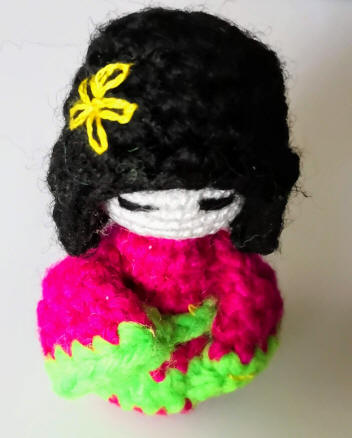
|
|
|
|
(Click pic for some hyperlink magic)
|
I did take the photo, though. I can also make paper planes, which used to impress my young son no end till he somehow became a computer geek & now designs digital planes instead. But, as usual, I digress (a trait I pretend to exemplify for comic effect in my role of Raving Reporter)...
Must admit am surrounded with Japanese artifacts & artwork, only some of which I mention here. Missed a few as I don't want this page to be too much of a list. Too late, mate, already is.
|
Spring flowers by Shoji screen
|
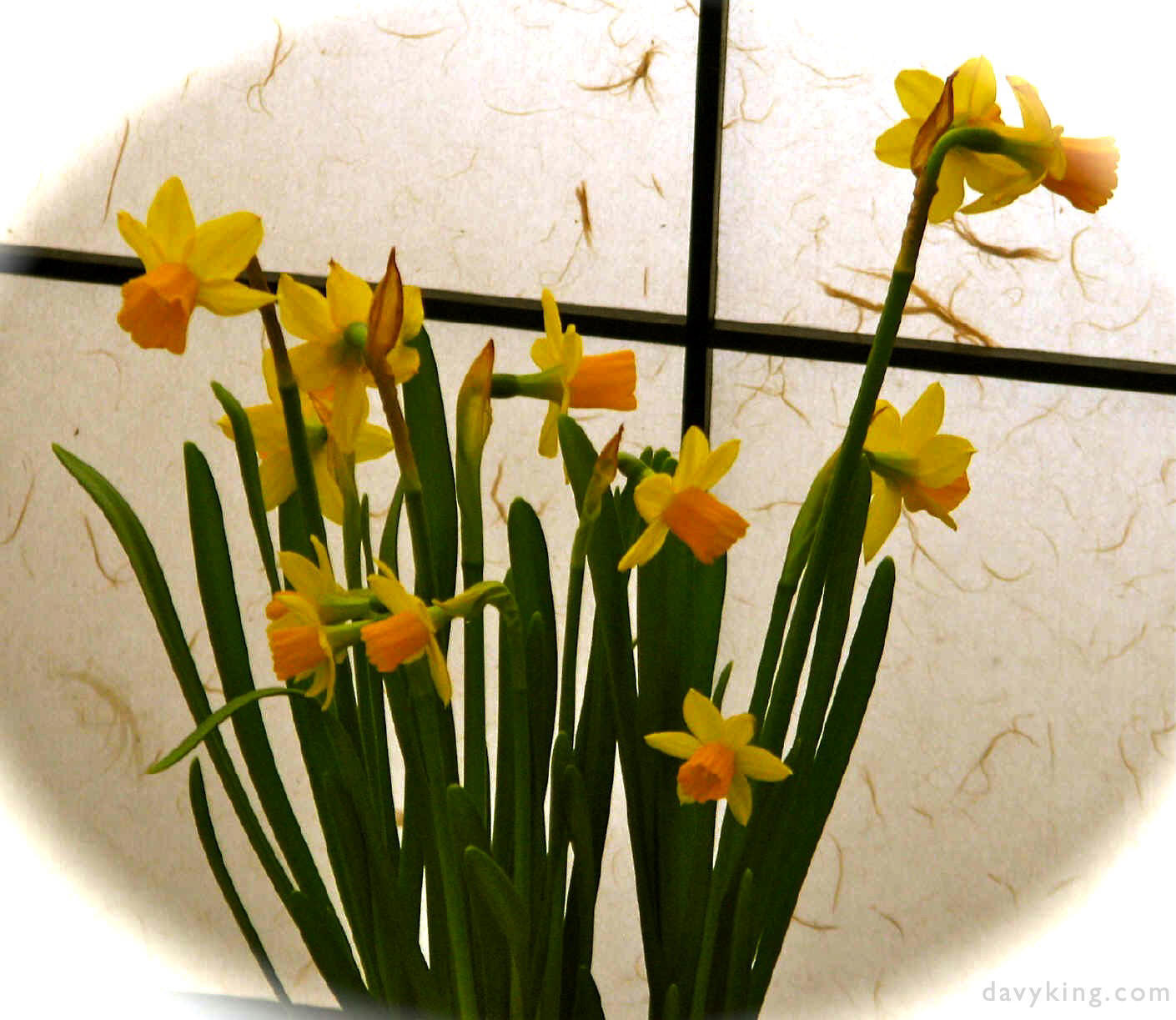 |
In Hanakotoba (the language of flowers), daffodils represent respect.
"It could be made sightly with minimal outlay on a few plants. Nothing fancy. Fields of Asphodel would be excessive. A full-blown indoor botanic garden’s uncalled for. But modest ikebana none could fault." ( Quote from my short story, S.S., page7)
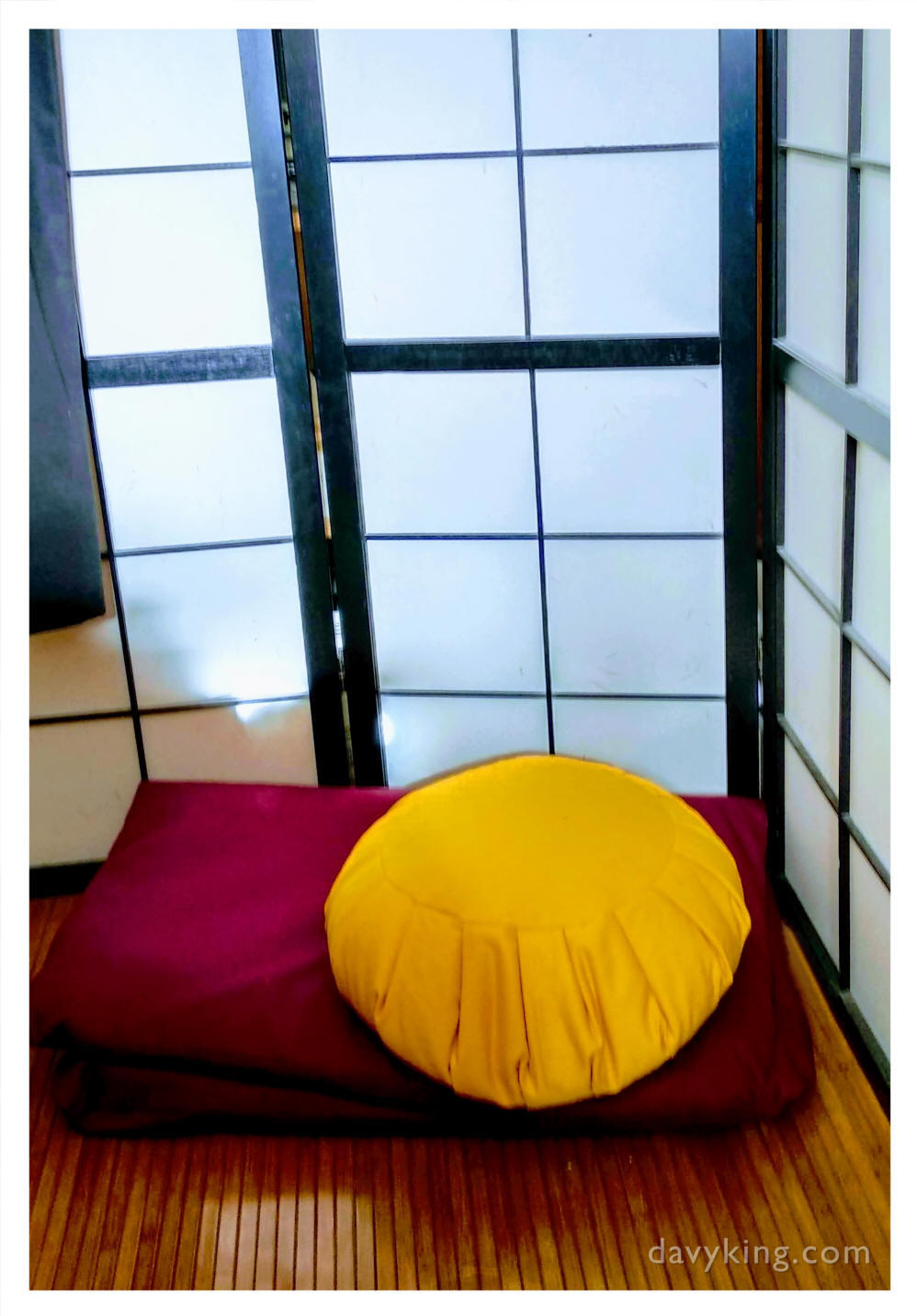
That's my quiet corner with minimalist Shoji screen, Zafu, folded Zabuton, Bamboo mat.
if all seems S.N.A.F.U.
sit on zafu
staying still
will fulfill
***
To be honest (& what else would you expect from Yours Truly™ ), I know hardly any Japanese words (I've used most of those I know on this very page, peppering my prose with them to add verbal piquancy, as I dash off some metaphorical Dashi for your delectation - see food section above if you need culinary recommendations), but I do like the aesthetic sensibility suggested by the following:
Shibui refers to beauty revealed by the passage of time. Thinking carefully about the subtleties of its meaning is quite a deep contemplation in itself. Am only beginning to get it, as I'm improving with age. Of course, I would say that! By the way, have you noticed the muted grey?
Fukinsei is beauty in asymmetry. Plenty of irregularity on this page. Beautifully askew.
Kodawari, for which there is no succinct English expression, alludes to determined attention to detail, a self-disciplined devotion to one’s art, craft or skill, even though one’s efforts are unlikely to be recognised And don't I know that about the creation of this website over many long years!
Yūgen is deep awareness of the universe, subtle beauty & grace that derives from understatement.
|
Kanso, simplicity, a reminder to perceive beyond what one immediately sees. A Zen Garden is a good example. This page is much too cluttered for that. Could do with a virtual Marie Kondo to clear up some of the digital detritus & clutter.
|
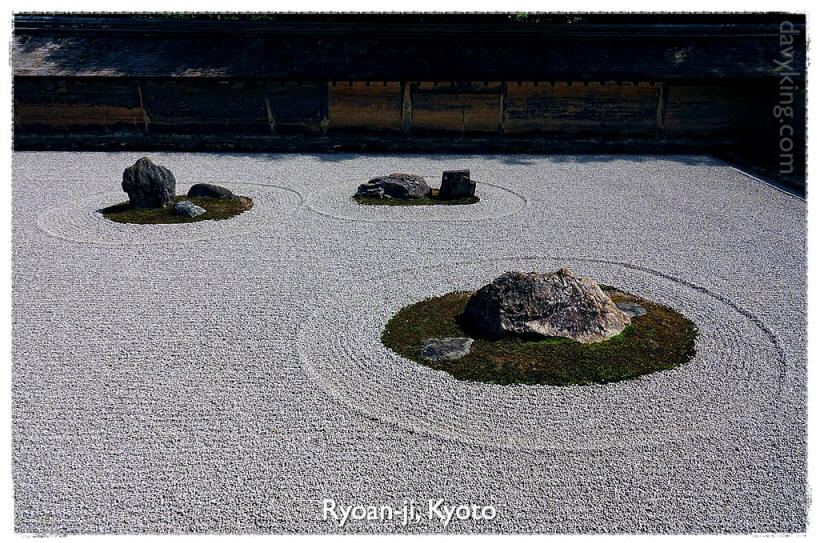 |
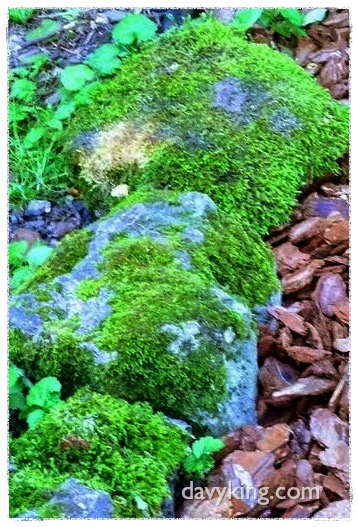
Also, carefully placed some stones:-

Merely skimming the surface here. Books* have been written on the subject. Have consulted a few. Must look into this more, if time & inclination allow. I have "Beginner's Mind" (Shoshin) when it comes to these Japanese terms & concepts. Not sure I achieve any of these qualities on this or any other page or in my website as a whole, that is not for me to judge. Somehow doubt it but might strike lucky by chance.
***
Am an aficionado of aspects of Japanese culture. Please note, am not a Japan-fan in every respect. Fascinated by the aesthetics of the Edo Period in particular. That was 1603 to 1868, which leaves out rather a lot of Japanese history. The Edo period appeals to me as it is said to have been characterised by peace, stability & prosperity. Unfortunately, there was a feudal Military dictatorship - which certainly wouldn’t be my chosen form of government, as politically I’m of a libertarian socialist persuasion.
The isolationist foreign policy (Sakoku - meaning “country in chains: or “lock up of country”) for 214 years under the Tokugawa Shogunate sounds restrictive compared to contemporary globalisation but successfully kept out the colonialist, religious influence of Portugal & Spain (cf. Philippines).
Edo was made the seat of government of Japan by the Tokugawa Shogunate. It was only a small village around 1600, when they set up a fortress city there. By 1700 it was the largest city in the world (population a whopping 1,200, 000.) Kyoto, where the Emperor lived, remained the formal capital till Edo was renamed Tokyo in 1868.
***
 |
The crest (mon) of the Tokugawa clan was triple wild ginger (aoi) leaves.
Recently used a Triquetra symbol on another page, which delved in to my Celtic heritage & am delighted to discover it is also used in Japan, as Musubi Mitsugashiwa. Could well adopt it as family crest. |
|
|
 |
|
|
*** Maybe this page is a very belated,
latter-day example of “Japonisme,” a term used by a French art
critic to describe the influence of Japanese art & design in
late 19th century Western Europe, after trade
was reopened with Japan, at the end of the Edo
period, following the fall of the shogunate & restoration of the Emperor.
|
|
***
| My interest in Japanese traditional culture goes way back. Memory of Kabuki theatre of Japan, which I witnessed at Sadler's Wells, London in June 1972. Dance-drama lasted many hours. Between dancing, longueurs of incomprehensible japanese dialogue, characters sitting motionless. Colourful costumes. Spectacular indeed. Did I enjoy it? Yes & Noh! |
|
Reminds me how this influenced Bowie via Kansai Yamamoto.
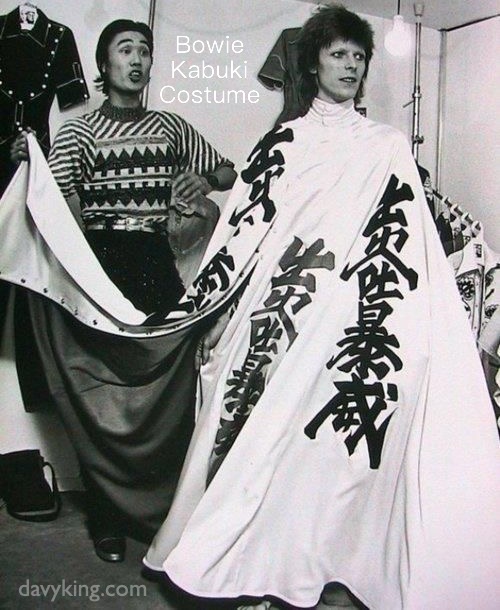
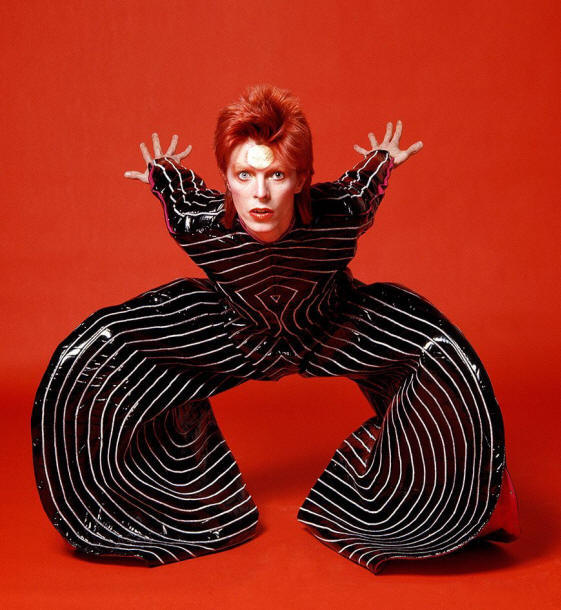
|
|
|
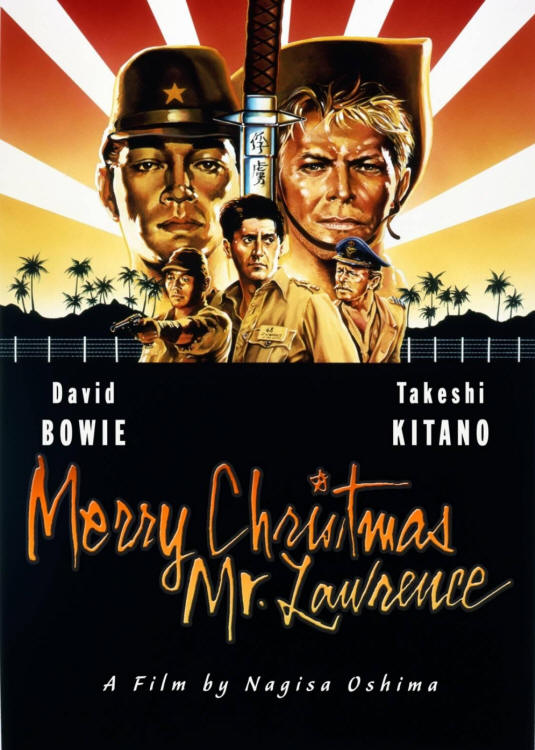 |
| Bowie's instrumental "Crystal Japan" is very evocative, even though somewhat incongruously used as the soundtrack of an advert for Shochu Crystal Jun Rock. (You can hear it here & see photos of Bowie in a kimono.) |
|
|
In a song called “Blackout” on “Heroes,” Bowie sings “I’m under Japanese influence and my honor's at stake.” In "Moss Garden", an instrumental track on the same album, he plays the traditional Japanese string instrument the koto. Bowie wrote "spent some nights in old Kyoto, sleeping on the matted ground" (in the song Move On.) That was "Lodger" period Bowie.
| "Turning Japanese" by the Vapors (whatever happened to them after worldwide success? Evaporated I guess) is admittedly very upbeat & catchy but hardly as aesthetically pleasing as Bowie's Japan-influenced tracks mentioned above, let alone Tony Scott's sublime Music for Zen Meditation, left, (a track of which is now playing if sound is enabled in your browser) or traditional Japanese music with koto (right), shakuhatchi, shamisen. |
|
I don't have even a tatty Tatami mat but I sleep soundly (times I'm not tossing & turning, insomniac) on firm flat futon, a runway from which to vertically take off & fly to dreamland, hopefully not making a splash, crashing into waves or American Destroyers. Except when feeling too lazy, I fold futon to save space during day. There are, of course, other things than sleep one can do on a mattress. For instance, I could make believe it's a raft to float on...
***
“Ukiyo (浮世, "floating, fleeting, or transient world”)…. The term ukiyo (when meaning the Floating World) is also an ironic allusion to the homophone ukiyo (憂き世, "Sorrowful World", the earthly plane of death and rebirth from which Buddhists sought release. In it's modern usage, the term ukiyo "The Floating World" refers more to a state of being: living in the moment, being detached from the bothers of life.” - Wikipedia
***
What I know about the Edo period comes mainly from Ukiyo-e, pictures of the floating world. Traditional subject matter included beautiful women, interiors, Nature (mountains, landscapes, birds, flowers), Sumo wrestlers, courtesans, Kabuki actors, geishas, teahouse mistresses, warriors, literary, historical, folklore characters.
Of the manifold prints of beautiful women (bijin), not all are demure & delicate. Modesty prevents me from plunging too deeply or enthusiastically into the genre of explicit exotic erotica, which leave little to the imagination, but I shouldn’t entirely shun Shunga ("Spring pictures," a euphemism if ever there was one, full of the joys of Spring, the rising sap etc, though sex in other seasons is depicted too). There you'll find copious copulating couples, no shortage of massive male members & inviting voluptuous vulvas on show. For instance, this, by Moronobu Hishikawa (considered the father of Ukiyo-e), called The Writing Lesson, is very educational:
I have some experience giving such private tutorials.
As a cunning linguist, can also teach Latin. I know showing off funny foreign words like fellatio sucks but they mean a lot to me. I’ve had what you might call a broad education. Have educated a few broads, to use a slightly male chauvinist term from the 1930s - "broads" refers to the anatomical fact that women tend to have broader hips than men. (In the 1960s they were called hippies - am just playing with words!) Mathematically-speaking, the answer to the following sum is, of course, 69 (or soixante-neuf, to get back to foreign language teaching):
Many of the prints are heterosexual, “straight” (which shouldn’t suggest that there is anything "bent" about homosexuality). Not all though. For instance, Hokusai (see above) pictured two lascivious lesbians here:
He went wilder than that, even showing bestiality. Thankfully not animal exploitation, as the two octopi seemed to be having fun & the shell diver remains passive, as she enjoys sub-aquatic cunnilingus of the cephalopod sort:
Will never be able to look at his Great Wave in the same way again, imagining what might be going on beneath it. The Beatles' "Octopus's Garden" takes on new meaning!
"In the Realm of the Senses," (L'Empire des Sens), the controversial, 1976, French-Japanese art film, directed by Nagisa Oshima (vide above) was considered shocking when it came out. But Edo period Shunga reveals that sexually explicit Japanese art is nothing new.
***
Ukiyo-e
eye
see old pictures of the floating world
my ego's Edo's evanescent Eden
long before our modern fall
how transitory this new now
we are all drowning in
some of us temporarily
keeping our heads above water
waving
nonchalant or frantic
a few may even surf for a while
with a winning smile
Great Wave about to break over our heads
|
|
|
(to hear embedded sound, enable audio in browser)
|
|
||
|
While a little tipsy on saké , I tripped & a
ccidentally dropped this page. It broke. Guess it shows. See the cracks, highlighted with gold.So, in the spirit of wabi-sabi, this page remains unfinished
& definitely ain't perfect.
***
|
Now, reader/viewer, if you listen carefully, you may hear a distant plop, the sound of Basho’s frog - Think it came from this direction...
Please consider making a donation The cost of a cup of coffee/tea will help keep my site up
|
|
|
|